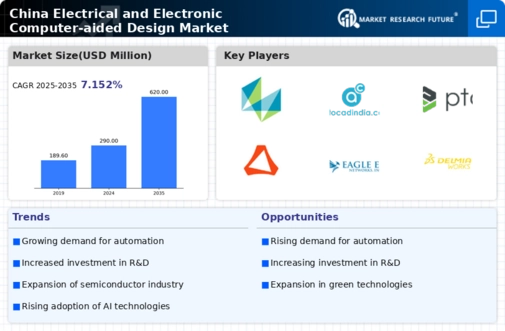By improving design accuracy and efficiency, artificial intelligence and machine learning technologies are becoming more integrated into the China Electrical Electronic Computer-Aided Design (ECAD) industry. The necessity for cutting-edge ECAD tools that simplify intricate design processes has grown essential as the demand for complicated electrical components rises.
Additionally, China's fast-growing consumer electronics, automotive, and telecommunications sectors are driving the use of ECAD systems, which enable quicker product development cycles and speedier prototyping.Businesses have a great chance to investigate and seize the expanding need for top-notch ECAD software because of the nation's strong emphasis on innovation and the numerous government programs designed to strengthen its semiconductor and electronics industries.
There has been a noticeable shift in recent years toward cloud-based ECAD systems, which allow for better design team communication and real-time project updates. This is especially important in China, where there is a growing movement to digitalize design and production processes.Additionally, ECAD software developers are being pushed to produce more adaptable tools that facilitate system-level design and integration by the growth of Internet of Things (IoT) applications. As more businesses use eco-friendly design techniques, sustainability is also emerging as a key subject.
The development of China's electrical and electronic industry highlights the need of utilizing cutting-edge ECAD solutions to maintain market competitiveness as the country seeks to establish itself as a worldwide technology leader. All things considered, these patterns show that the China ECAD market is changing due to the development of new technologies and the desire for operational excellence.
China Electrical and Electronic Computer-aided Design Market Drivers
Increasing Demand for Advanced Electronics
The rapid expansion of the electronics sector in China is significantly driving growth in the China Electrical and Electronic Computer-aided Design Market. With China being the largest manufacturer and exporter of electronics globally, the demand for cutting-edge consumer and industrial electronics is on the rise.As per the Ministry of Industry and Information Technology (MIIT), the production value of the electronics industry in China reached approximately 6.5 trillion Chinese Yuan (about 1 trillion USD) in the last year.
This surge in production necessitates advanced design tools and software, leading to a heightened demand for Computer-Aided Design solutions that enhance efficiency and innovation in electronic product development.Established companies like Huawei and Xiaomi are investing heavily in Research and Development to create more sophisticated products, thus driving the need for advanced design software in the sector. Such developments are expected to significantly contribute to the projected growth of the market.
Government Initiatives and Policies Promoting Technology Development
The Chinese government has been actively promoting technological advancements through various policies and initiatives aimed at enhancing domestic capabilities in electronics and electrical design.Programs under the 'Made in China 2025' initiative emphasize innovation and the integration of advanced technologies in manufacturing, especially in the area of Electrical Electronic Computer-Aided Design innovation.
Additionally, the '14th Five-Year Plan' outlines substantial investments aimed at bolstering capabilities in software, including design tools. This proactive approach by the Chinese government is creating a favorable environment for growth, leading to increased domestic competition and a necessity for companies to adopt advanced Computer-Aided Design technologies to maintain market relevance.
Growing Adoption of Smart Technologies
The rise of smart technologies, including Artificial Intelligence and the Internet of Things, is presenting new opportunities for the China Electrical and Electronic Computer-aided Design Market. As industries integrate more smart technologies into their products, the need for sophisticated Electronic Computer-Aided Design solutions that can efficiently handle complex integrations becomes crucial.
According to the China Internet Network Information Center (CNNIC), the number of Internet of Things devices in China is expected to surpass 30 billion by 2025. This influx of devices not only raises the complexity of design requirements but also reinforces the necessity for advanced Computer-Aided Design capabilities that can streamline the development process and enhance product functionality.
China Electrical and Electronic Computer-aided Design Market





















Leave a Comment